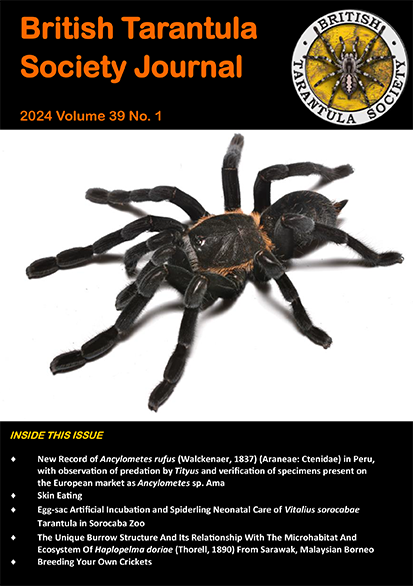Keeping Tarantulas – The Basics
Richard C. Gallon
This article is intended to be a care-guide covering the basics of tarantula keeping. Jargon has been kept to a minimum to increase readability for beginners. We’ll assume that a ground-dwelling tarantula is being catered for – since that’s the most appropriate type of spider for the beginner.
Also see our Tarantula help guide
Housing
Many containers can be used for housing tarantulas, but since this article is aimed at the beginner I assume you’ll want maximum visibility. An ideal choice would be a small glass fish-tank (30x20x15cm). These usually come with a perfectly adequate plastic lid, but you might have to seal any feeding holes to prevent escape (tarantulas can walk up glass). This can be easily done with hard-drying glue or aquarium silicon sealer (not bathroom sealer because it contains harmful fungicides). You’ll only need one or two small (2-4mm) ventilation holes in the lid – too many will cause problems with maintaining humidity. Tarantulas are fairly strong and can push light-weight lids off easily (a book or stone placed on top of the lid stops this). It may come as a surprise to novice keepers that tarantulas are kept in small tanks. This is a reflection of the way tarantulas live in the wild. Many species rarely move more than 10cm from their burrow entrance (most types of tarantula live in holes they dig into the ground). A tarantula burrow is not the most roomy place in the world, so it’s quite possible to provide ample living space in captivity.
Tarantulas must be housed singly because they are highly cannibalistic.
Substrate
Now you have the tank you’ll need to spread a layer of compost (substrate) over the base. There are many suitable choices of substrate, but perhaps the most readily available is moss peat (the one that doesn’t have added fertilisers). It’s best to sterilise this before use because there are parasitic mites in it which will attack your spider. Sterilise the damp peat by cooking it in a microwave (10 minutes on high) or conventional oven (30 minutes). The idea is to heat the substrate so that it generates steam which then kills any nasties lurking in there. Once the substrate has cooled down you can spread a 3-5cm deep layer all over the base of the tank. It’s best to allow one side of the tank’s substrate to dry out (this is likely to be the heated end – see below), and ensure the other side is moist (not sopping wet). Pour water onto the the substrate to maintain dampness (you might only have to do this once every couple of weeks). Tarantulas need a humid atmosphere to survive, but a closed, saturated atmosphere is detrimental to their health.
Hiding place or retreat
Tarantulas are essentially nocturnal (active at night & inactive by day) and all need a dark shelter where they can hide in during daylight hours. A simple shelter can be constructed from a plastic plant-pot which has been cut in half. You can sink this into the substrate making sure the inside is dark and there’s an entrance just big enough for the spider to squeeze through. Cork-bark slabs can also be used to create shelter. These don’t go mouldy like ordinary wood pieces which are best avoided. Tarantulas will often dig into the substrate and modify their shelter.
A good rule of thumb – “a happy tarantula is one you can’t see.”
Avoid using fish-tank ornaments, particularly those resin logs with holes in them (tarantulas can get stuck in these). Remember that anything sharp is likely to injure and eventually kill your delicate spider. For obvious reasons cactus plants don’t mix with tarantulas!
Water-dish
It is also a good idea to include a water bowl – a plastic plant-pot dish is ideal. It is impossible to drown a tarantula because they are covered in water-repellent hair, so there’s no need to put any sponge in the dish (it will only encourage mould to grow anyway). It’s often a good idea to place a piece of rock in the dish – this allows crickets to escape (they can drown and will spoil the water when they do).
Basic lay-out of a tarantula tank showing plant-pot retreat, rock in water-dish and substrate. The plastic-tarantula is just for illustration purposes!
Heating
All tarantulas come from tropical or sub-tropical areas, so unless you live in such a place, you’ll need to supply additional heating (unless your house is heated at a constant +25C). The most practical kind of heating for our purposes is the “heat-mat.” This is a thin, black heating element which you put to the rear of the tank and backed up with a thermal insulator to reflect heat bak into the tank ( do not place underneath as this can cause an overheat problem with the mat and injury to your tarantula). These are manufactured in various sizes, but you only need one that’s half the size of the tank’s back, because you only want to heat half the tank. This gives the spider the opportunity to regulate its own temperature by moving to the hot or cool side. Thermostats are available to regulate the heat, but they are not essential. Many people leave heat-mats on all day or have them on plug-in-timers to come on at half-hour intervals. Remember that household summer temperatures are sufficient for most tarantulas (so you can turn heat-mats off during the summer months). An ideal temperature to keep tarantulas at is between 22-30C. Below this temperature they become sluggish and may stop feeding. It’s best to avoid temperatures over 30C. This isn’t a exacting science, so temperatures can be allowed to vary.
Remember – tarantulas hate light, so don’t be tempted to use a light bulb to heat the tank.
Avoid placing your tarantula tank near a window. The sun’s rays can rapidly turn your tank into an oven, killing the spider in the process.
Feeding
Tarantulas are carnivorous. The mainstay of their captive diet is live crickets, but they will take a wide variety of insects (mealworms and their beetles, locusts etc.). These are readily available through mail-order companies and some specialist pet-shops. As a general rule tarantulas will readily eat food items which are half their own body length or less. A typical-sized, adult tarantula will be content with four large crickets per week. They don’t need to be fed very frequently; you can give them all the crickets at once and that will be fine for the rest of the week. In fact a healthy, previously well-fed, adult tarantula can go without food for over a month with no ill effects.
Most tarantulas will also take dead food. This can be small pieces of raw, lean beef (1cm cube) or thawed baby mice (available from pet-shops who specialise in reptiles). Simply place the food item near where the tarantula frequents and it’ll find it. Any dead food which hasn’t been eaten within 24 hours must be removed and discarded (otherwise it will decompose rapidly).
When a tarantula has finished feeding it will leave a small ball of indigestible leftovers. These should be removed from the tank during routine maintenance (long tweezers are useful here).
Tarantulas produce negligible amounts of faeces (tiny white packages) and as a result, don’t need to be cleaned-out like other small animals. It is perfectly fine to keep a tarantula on the same substrate for well over a year (so long as you remove food leftovers). Tarantulas dislike disturbance, so frequent substrate changes would be stressful for them.
Moulting
For a tarantula to grow it must shed it’s hard outer skin. Adult tarantulas shed their skin approximately once a year (younger ones more frequently). They’ll usually do this within their retreat. A tarantula which is about to moult will often seal itself into its retreat with a plug of substrate or wall of silk (don’t be tempted to open it up).
Before a tarantula moults it will usually stop taking food. When this happens you must remove any live crickets which are loose in the tank (they can damage and kill moulting tarantulas). Tarantulas typically moult on their backs. If you find a tarantula in this position DON’T turn it over. A moulting tarantula must never be disturbed. They will shed their skin in one piece and this process can take up to 24 hours to complete. A freshly-moulted adult tarantula will only start feeding after its new skin has hardened. This might take over a week, so don’t try feeding during this period.
Handling
Tarantulas are not domestic animals and don’t appreciate being held. They are extremely fragile creatures which are easily damaged and falls often result in death. For this reason the BTS advocates a “no handling policy”. In America handling tarantulas is often viewed as an important “civil liberty”, but at the end of the day it must be the welfare of the spider which is the number-one priority.
The safest way to move a tarantula is to coax it into a plastic, screw-topped jar with a long thin stick (such as a knitting-needle). You’ll only need to gently touch the spider’s rear legs to encourage it to move forwards. Once the spider’s in the jar you can put the lid in place.
All tarantulas possess venom and can bite humans. However, despite this, the venom of most species rarely causes anything more than localised aching around the bite area. The effects being reminiscent of a bee sting.
Recommended species
African and Asian tarantulas are best avoided by the beginner as they are generally more aggressive than American ones. However, most American tarantulas have irritating hair on their abdomens which they can kick towards disturbances (such as their owner). These hairs cause an itching sensation when they make contact with human skin, so contact with these is best avoided. Some types of tarantulas are more likely to kick these hairs than others.
Good tarantulas for the beginner include: Captive bred please
Grammostola rosea – Chilean Rose. All other Grammostola species are equally suitable.
Brachypelma albopilosum – Curly Hair. One of the best starter tarantulas available.
Brachypelma vagans – Mexican Red Rump. Another excellent starter spider.
Brachypelma smithi – Mexican Red Knee. This one has a strong tendency to kick irritant hairs.
All other Brachypelma species.
All Aphonopelma species.
An average tarantula can be expected to live for about 10 years.
It is far more ecologically-sound to purchase captive-bred tarantulas. These have the advantage of youth and don’t carry parasites like some wild-caught specimens. Captive-bred Brachypelma species are readily available, but usually as tiny spiderlings. Larger sizes are available, but are often more pricey than wild-caught adults because of the care taken in rearing them.
Once you have gained practical experience of tarantula keeping, you might wish to consider using alternative, more environmentally-friendly, substrates. Coir (coconut fibre) is an excellent alternative, but some brands have a tendency to go mouldy. Many keepers like to mix horticultural vermiculite into their substrates. This reduces the amount of peat used. Because peat is mined from an important ecological habitat (peat bogs), we all have a moral responsibility to reduce our consumption of it.
Purchasing cork-bark pieces is also a sound conservation policy. Cork bark is sustainably harvested from natural cork oak woodlands in southern Spain. By purchasing this product you ensure the long-term survival of this woodland habitat, which might otherwise be turned over to intensive agriculture.
The BTS website provides a Forum where anybody can post tarantula-related questions. Members will often be able to provide answers within a matter of hours. In addition to this, BTS Committee members will gladly assist anybody with tarantula inquiries. If you wish to take your interest further you might like to consider joining the BTS. For a very reasonable sum of money your membership provides four, exciting colour journals every year. These journals are cram-packed with the very latest information on tarantulas. A membership form can be found on this website.




